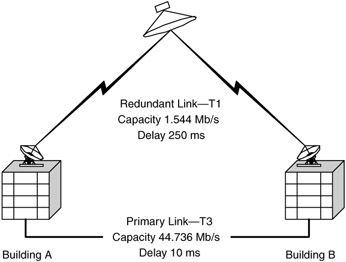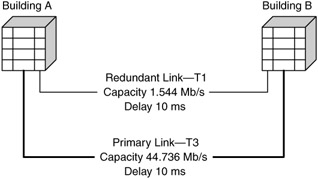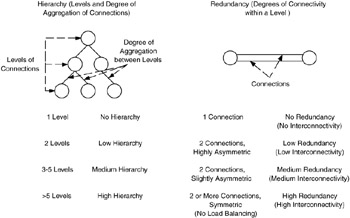11.8 Applying Interconnection Mechanisms to the Design
11.8 Applying Interconnection Mechanisms to the Design
Interconnections are important from at least two perspectives: They are used to change the degree of concentration of networks or flows at the interconnection (hierarchy), as well as the number of alternate paths provided by the interconnection mechanisms (redundancy). Recall from Chapter 1 that a major trade-off in networking is between hierarchy and interconnectivity. In this chapter, we consider the use of interconnectivity to provide redundancy in the network.
11.8.1 Hierarchy
Throughout the first part of this book, we looked for locations where information comes together in the network, whether it is applications, users, flows, or broadcast domains, and we examined where boundaries between areas occur. Such locations point to a consolidation of information, which leads to the formation of hierarchies in the network. Hierarchies play an important role in interconnection mechanisms, for as they indicate consolidation points in the network, they are likely to show where multiple technologies interconnect.
Some metrics for measuring hierarchy in the network are the concentration of flows, technology connections at or within an area, and the number of networks or areas that are interconnected. We can describe the degree of hierarchy as low, medium, or high, based on the following criteria (Figure 11.15):
| Degree of Hierarchy | Concentration of Routing Flows/Levels |
|---|---|
| None | 1:1 |
| Low | 2:1 |
| Medium | 3-5:1 |
| High | >5:1 |
Figure 11.15: Degrees of hierarchy.
11.8.2 Redundancy
Redundancy, or the number of alternate paths in the network, is an important part of providing reliability in the network. Another commonly used term associated with redundancy is path diversity. Looking at the number of alternate paths is a fairly simple view of redundancy and is not end-to-end. To evaluate end-to-end redundancy, we must consider all components in the end-to-end path, which is often a complex task. A simple view of redundancy is often sufficient in determining criteria for interconnection.
During the requirements and flow analyses, we discussed and listed service metrics for reliability, but until this section, we have not been able to do much in the network design to support it. Where mission-critical applications and predictable/guaranteed reliability occurs in flows, redundancy is likely to be required. There are two components of redundancy to consider: the number of paths at convergence points and the degree of redundancy provided by alternate paths. In providing alternate paths in the network, there will be locations where these paths converge. It is at these convergence points where redundancy effects the interconnection mechanism.
Alternate paths can provide various degrees of redundancy in a network. Consider the following examples.
Low-Redundancy Path
In a low-redundancy path, the alternate path may not be immediately available when the primary path is disabled. There may be some configuration, possibly even human intervention, required to make the alternate path operational. This means that there will be a significant delay, on the order of minutes, while the alternate path is brought up. Furthermore, the performance characteristics of this alternate path may be significantly less than those of the primary path.
Low-redundancy paths are often known as cold spares. This is the same situation as when a failed component requires replacement from on-site spares before service can be restored.
Figure 11.16 shows a path with a low degree of redundancy. This means that the user or application will encounter a disruption in service and degradation in perceived performance, in terms of either greater delay or loss of the application session.

Figure 11.16: Low-redundancy path.
Medium-Redundancy Path
In a medium-redundancy path, the alternate path is readily available (i.e., no significant setup time to bring the alternate path up). However, the alternate path has a lower degree of performance than the primary path. Readily available means that the alternate path may be immediately available or there may be a short wait (milliseconds to seconds) while flows are rerouted across the alternate path, but no human intervention is required.
If the time to switch to the redundant path is faster than the time required to notice the failure, it can be considered auto-switch-over redundancy. When the failure is noticed before the path can be switched, it can also be termed a hot-standby path.
In Figure 11.17, the redundant path (the T1) is ready to work and can be cut over quickly by a routing protocol. It has lower capacity, however, and would likely result in degraded performance for its users. This is a medium degree of redundancy, where users and applications will (usually) not notice a disruption in service, although there will be a degradation in perceived performance when the alternate path is established.

Figure 11.17: Medium-redundancy path.
High-Redundancy Path
The highest degree of redundancy is when one or more alternate paths are readily available and the performance of each alternate path is the same as that of the primary path. In Figure 11.18, the redundant path is equal in performance, both capacity and delay, to the primary path.

Figure 11.18: High-redundancy path.
A high-redundancy path means that important users and applications (e.g., mission-critical or real-time applications) will not notice a disruption in service and will enjoy the same level of performance with the alternate path. Ideally, this degree of redundancy means that users never notice when the primary path fails. We have to be careful when applying this degree of redundancy, for there is a tendency to ignore failovers when service to users and applications does not change. Thus, network management needs to be able to identify when such failovers occur and must notify management.
When equal performance paths are used and the traffic load is shared between them during normal (nonfailover) operation, this would not be considered high redundancy. When the normal traffic load is shared across the equal paths, the loss of the primary path would result in a perception of degraded performance by users.
An obvious trade-off between the different degrees of redundancy is in cost. Providing a low degree of redundancy is relatively cheap, and a high degree of redundancy is almost, if not entirely, equal to building a second backup network.
We can summarize the degrees of hierarchy and redundancy as low, medium, or high, based on the guidelines developed in this book and shown in Figure 11.19.

Figure 11.19: Guidelines for hierarchy and redundancy.
These guidelines for hierarchy and redundancy in the network are useful not only in developing interconnection mechanisms but also in developing network management, security, and addressing and routing strategies for our design.
EAN: 2147483647
Pages: 161